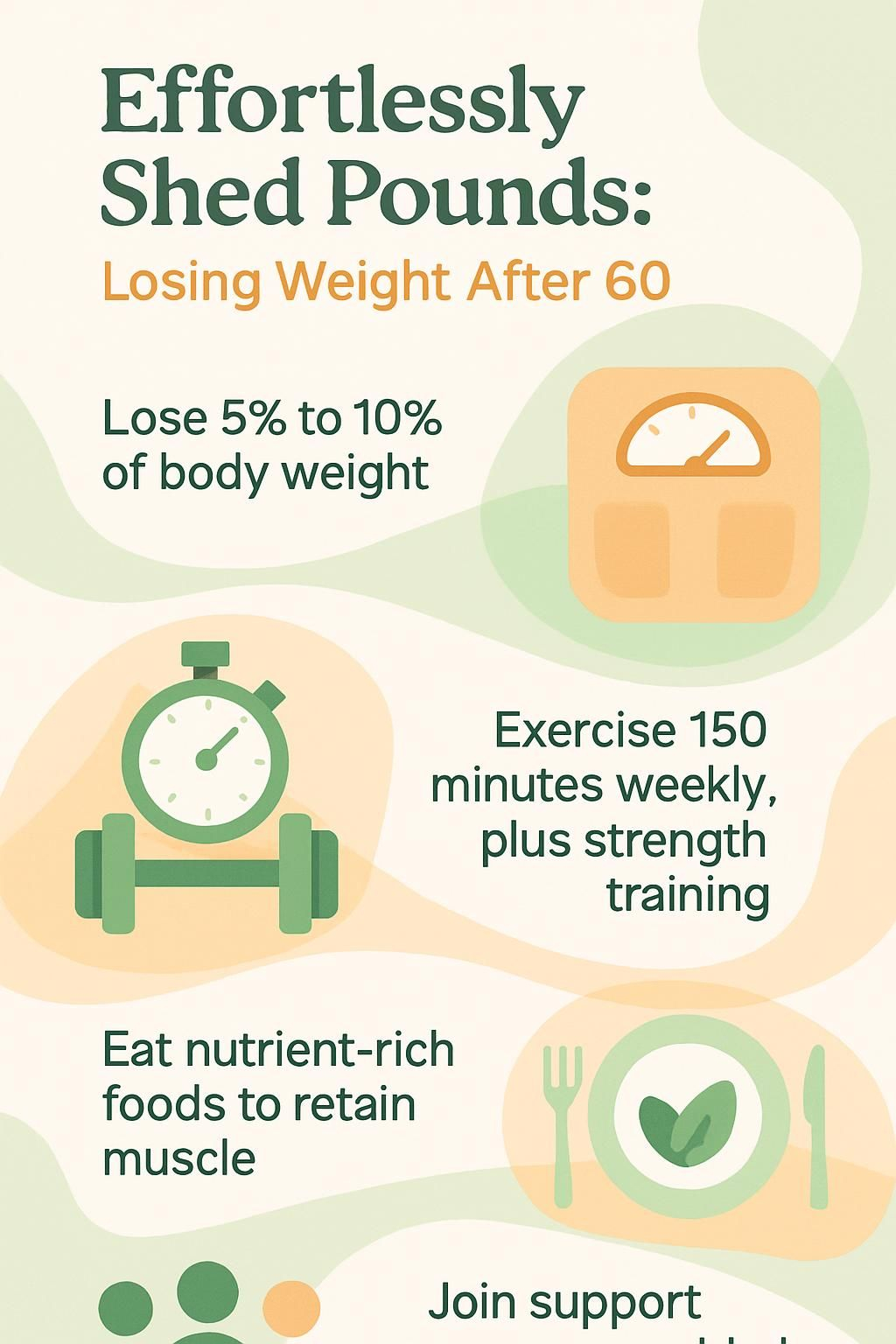Effortlessly Shed Pounds: Losing Weight After 60
Our Nutrition Assistant AI Suite will transform your body. You will lose fat, get toned, and build muscle. Gain confidence and optimal health.
Losing weight after 60 can feel frustrating, even when you eat less and move more. As you get older, metabolism slows, which means your body burns fewer calories at rest. This shift makes weight loss, especially belly fat, tougher but not impossible.
This article explains why these changes happen and shows simple steps you can use. You will learn how to shape a healthy diet, build an exercise plan, stay hydrated, and set realistic goals for safe progress. Keep reading for clear, practical advice for weight loss in your 60s.
Key Takeaways
- Adults lose about 3% to 8% of muscle per decade after 30, which lowers metabolism and makes losing weight harder, according to Mayo Clinic and Joanna Li, RD.
- Losing 5% to 10% of body weight can improve blood sugar, blood pressure, and heart risk, supported by Mayo Clinic Diet and CDC data.
- Aim for at least 150 minutes of moderate activity weekly plus two strength training sessions to slow age-related muscle loss and support weight control.
- Choose nutrient-rich foods like vegetables, fruit, beans, whole grains, nuts, fish, lean protein, and healthy fats to protect muscle and manage hunger.
- Support from groups, trainers, or dietitians improves motivation and helps manage barriers linked to medications or health conditions such as diabetes or arthritis.

Challenges of Losing Weight After 60

Losing weight after age 60 feels different because your body changes with time. Understanding what shifts, then adjusting your plan, helps you make smarter choices about food and physical activity.
How does metabolism slow down with age?
Metabolism is how your body turns food into energy. As you age, muscle mass declines, so your body burns fewer calories, even when resting. Joanna Li, RD, notes that less muscle means a slower calorie burn.
Research shows most people lose 3% to 8% of muscle each decade after age 30. With less muscle, the body uses fewer calories and stores more fat around the abdomen. You also need fewer calories after 60, and long gaps between meals can slow metabolism even more. Without a plan, this can lead to belly fat and gradual weight gain.
What hormonal changes affect weight loss after 60?
Hormones also shift. Estrogen and testosterone drop with age, which slows metabolism and promotes fat storage. Lower estrogen often leads to more fat around the midsection in women. Lower testosterone can reduce muscle in men, which cuts daily calorie burn.
Insulin resistance, which is when cells do not respond well to insulin, can rise with age. That makes blood sugar control and weight management harder. Thyroid hormone may also decrease, leading to fatigue and slower calorie use.
These hormonal changes can increase hunger and make your body hold on to calories. Adjusting your diet and adding strength training helps balance these shifts and supports steady progress.
The next section explains why muscle loss affects weight loss results.
Why does muscle mass decline impact weight loss?
Hormone changes after 60 can lower estrogen and testosterone, slowing metabolism. At the same time, you lose muscle as you age. Muscle burns more calories than fat while you rest, so losing muscle reduces daily energy use.
Mayo Clinic notes that most adults lose three to eight percent of muscle mass per decade after age 30. Old routines may no longer lead to the same results. Less muscle also makes long walks or swimming for the goal of at least 150 minutes per week feel harder.
Lower activity can lead to more visceral fat, which is fat around your organs. That raises the risk for type 2 diabetes, high blood pressure, heart disease, and sleep apnea.
“Muscle mass plays a key role in controlling energy use—even if you are sitting still.”
What Are the Benefits of Maintaining a Healthy Weight in Your 60s?
Reaching a healthy body mass index supports heart health and bone strength. It also boosts energy for daily tasks and helps prevent certain conditions.
How does a healthy weight reduce chronic illness risks?
Staying at a healthy weight can lower the risk for many chronic conditions. A nutrient-rich eating pattern that includes vegetables, fruit, whole grains, nuts, beans, and fish is linked to lower rates of diabetes, heart disease, high blood pressure, and sleep apnea.
Keeping BMI in the normal range lowers the chance of cardiovascular disease or type 2 diabetes. The CDC reports that losing just 5% to 10% of body weight can improve blood sugar and blood pressure.
Even small losses can reduce inflammation and improve cholesterol. I swapped white bread for whole grain and added beans and leafy greens. The result was fewer joint aches and more energy during walks.
These improvements build momentum. Better mobility often leads to more daily movement, which supports longer term results.
How does weight loss improve mobility and energy?
Losing excess weight reduces pressure on your joints, so moving feels easier. Walking, climbing stairs, and standing can become more comfortable as your body carries fewer pounds.
Research shows that a 5% to 10% weight loss can improve mobility in adults over 60. Less weight can also ease pain in knees, hips, and the lower back. More movement improves heart and lung function, which boosts oxygen delivery to muscles and organs.
Limiting screen time and staying active throughout the day lifts energy. These habits make weight control more manageable at any age.
What mental health benefits come with losing weight after 60?
Weight loss can support mental health. Many older adults notice better mood, more confidence, and improved sleep. The Mayo Clinic Diet highlights habit building, which can bring a stronger sense of well-being.
Eating more fiber and moving more helps create steady routines. These changes can ease stress and loneliness. Sustainable progress often improves self-esteem and enjoyment of daily life.
How Can Seniors Overcome Common Weight Loss Barriers?
Barriers are common after 60, yet small changes add up. The steps below support digestion, protect muscle, and help you burn more calories safely.
How can seniors safely increase physical activity?
Start small if you are new to exercise or have health problems. Try 5 to 10 minute walks or gentle chair exercises. Talk to your doctor before starting a new routine, especially if you take medication or have a chronic condition.
Build toward at least 150 minutes of moderate activity each week. Options include brisk walking, swimming, dancing, or cycling. Seek help from friends, caregivers, or local groups if you want company.
Community classes can make the first steps easier. As a volunteer coach, I saw people who began with short sessions improve mobility and energy within weeks. Listen to your body and adjust as needed.
What nutritional changes support appetite and weight loss?
Fill your plate with vegetables, fruit, leafy greens, whole grains, fish such as salmon, legumes, nuts, and low-fat dairy. These foods are rich in fiber and protein, so you feel full longer and support a healthy gut.
Choose lean meats and poultry for quality protein with less saturated fat. Limit sugary drinks and sweets so your body burns stored fat. Track your intake to spot patterns and hidden calories.
After 60, focus on smaller, nutrient-dense portions. Swap soda for water or unsweetened tea, and use smaller plates. I replaced chips with yogurt, hard-boiled eggs, or carrots, which cut hunger between meals. Aim for at least two servings of high-fiber foods daily to help trim abdominal fat and support digestion.
Next, learn how medication side effects can affect weight control after 60.
How do medication side effects affect weight management?
Some medications change appetite, slow metabolism, or increase fat storage. Drugs for blood pressure, diabetes, depression, or menopause symptoms may cause weight gain.
For instance, corticosteroids can shift fat storage. Some antidepressants may increase cravings. Doctors can sometimes adjust prescriptions to limit these effects. A registered dietitian can tailor your eating plan to fit your health needs.
Track changes and share them with your healthcare team. This helps you set realistic goals and manage side effects while you work toward a healthy weight.
Next, see why steady plans help you maintain results.
How Do You Set Effective Weight Loss Goals After 60?
Clear goals help you maintain a healthy weight and protect your health. Measure progress with simple data and regular check-ins.
Why is gradual, sustainable weight loss important?
Slow and steady loss, about 1 to 2 pounds per week, is safer for older adults. Fast drops can lead to muscle loss, lower bone density, and a weaker immune system.
The Mayo Clinic Diet and other programs for seniors focus on habits you can keep. Quick fixes often lead to regain. A steady approach protects muscle, supports organs, and lowers the chance of rebound weight.
After 60, your metabolism slows and needs for vitamin D, calcium, and protein rise. A gradual plan supports both physical health and emotional well-being.
Next, explore nutrient-rich foods that support weight control after 60.
What Are the Best Dietary Approaches for Weight Loss After 60?
Smart food choices help you manage eating and weight in your 60s. The ideas here are simple and practical.
Which nutrient-rich foods support weight loss?
Vegetables, fruit, whole grains, beans, nuts, and fish provide key nutrients for weight control. The Mayo Clinic Diet suggests filling half your plate with produce at each meal.
These foods offer vitamins, minerals, antioxidants, and fiber that support digestion and satiety. Protein sources such as salmon, eggs, low-lactose whey, and lean beef help maintain muscle during weight loss. Higher protein can curb hunger and support metabolism in older adults.
Healthy fats from nuts and olive oil support heart health and help you feel satisfied. A varied diet also lowers risk tied to obesity, including diabetes and heart disease.
How to balance proteins, whole grains, and healthy fats?
Once you include more nutrient-rich foods, aim for a simple balance. Target about 1 gram of protein per kilogram of body weight daily. For example, at 154 pounds, you need about 70 grams of protein.
Choose lean protein such as fish, chicken breast, eggs, or beans to support muscle as you age. Fill half your plate with produce, then add whole grains like brown rice, quinoa, or oatmeal for fiber and better blood sugar control.
Add healthy fats in small portions, such as nuts, seeds, olive oil, or avocado. Try easy swaps, like whole grain bread instead of white, or a handful of nuts on a salad.
Why reduce processed foods and sugar intake?
After you balance major food groups, cutting processed foods and sugar often speeds progress. These items pack extra calories and unhealthy fats with little nutrition. The Mayo Clinic Diet urges you to limit foods that add calories without value.
Reducing sugar helps manage blood sugar and blood lipids, which grows more important with age. For example, swap sugary cereal for oats, or pick fresh fruit instead of pastry. Many people report better energy and steadier mood when they reduce sugar.
How can portion control aid weight loss?
Portion control keeps your daily calories in check. The Mayo Clinic Diet uses sample menus, such as a 1,200-calorie day, to show how portions look at each meal. Small treats can still fit, such as 75 calories of sweets per day or spread across the week.
Tools like the Healthy Weight Pyramid teach you to fill most of your plate with produce and choose fewer high sugar or high fat items. This approach lets you eat more nutrient-dense foods without overdoing calories.
Serving smaller portions helped me lose several pounds after my 60th birthday while staying energized for walking and gardening. Watching portion sizes gives better control of carbs, supports digestion, and reduces extra visits to the clinic linked to weight gain.
What Exercise Is Recommended for Seniors to Lose Weight?
Exercise supports stronger breathing, better balance, and more muscle strength after 60. Start simple, then build your routine with confidence.
What are good moderate-intensity aerobic activities for seniors?
Brisk walking improves breathing, strengthens your heart, and helps manage weight. The Mayo Clinic suggests 30 minutes of moderate activity most days. If you are new to exercise, break it into 5 to 10 minute chunks.
Swimming is gentle on joints yet effective. Dancing burns calories and makes movement fun. Many people in my walking group say regular walks boosted their energy and mobility after 60.
Choose activities that you enjoy so they become part of your week.
How does strength training help preserve muscle?
Strength training, such as machines, dumbbells, yoga, or Pilates, helps slow age-related muscle loss. After 60, people can lose up to 3% of muscle each year if they stay inactive. Resistance sends a signal that tells muscles to grow stronger.
More muscle increases calorie burn at rest. A higher muscle percentage supports metabolism, even while you sleep. With gentle sessions three times per week, chores feel easier and energy often rises. Regular strength work supports healthy weight and daily function.
What low-impact exercises are ideal after 60?
After adding strength work, low-impact activities help protect joints while you stay active. Walking is one of the best choices. Start with short walks and add minutes each week. Thirty minutes, five days per week, supports heart health without extra strain.
Resistance band workouts are portable and joint friendly. Simple moves like curls or seated rows build strength safely. Many older adults enjoy yoga or Pilates for flexibility, balance, and core control. I tried chair yoga at a local center, and it eased back pain while improving mobility.
Pick activities you enjoy. That is the key to staying consistent.
What Lifestyle Changes Support Weight Loss After 60?
Small daily habits create a strong base for progress. Hydration, sleep, stress control, and meal timing all play a part.
How much water should seniors drink for weight loss?
Aim for about 64 ounces of water daily to support hydration and appetite control. Water can help you feel full and makes portion control easier.
If plain water is hard, include water-rich foods like cucumbers or tomatoes. Pale yellow urine usually signals good hydration. Using a reusable bottle helped me hit my goal each day.
Increase fluids if you exercise more or live in a hot climate. Good hydration also supports sleep, which affects weight control.
Why is sleep quality crucial for losing weight?
Sleep supports hormones that control hunger and fullness. Most adults need 7 to 9 hours per night. Poor sleep can raise hunger, slow metabolism, and lead to higher calorie intake.
Adults who sleep less than 7 hours often gain more weight than those who sleep enough. Your body recovers during sleep, which balances appetite and energy use. High stress hormones from short sleep make weight loss harder.
A simple bedtime routine reduced my night snacking and made morning walks easier. Good sleep helps you stay in control and consistent.
What stress management techniques help with weight?
Chronic stress raises cortisol, a hormone that increases cravings and fat storage. Exercise helps lower stress and supports healthy aging.
Yoga and meditation promote calm and can reduce emotional eating. The Mayo Clinic Diet highlights simple habits like mindful breathing and regular movement to ease stress. Better stress control helps you keep healthy eating patterns.
Set aside a few minutes daily for relaxation. It pays off in better choices.
Why avoid late-night snacking?
Late-night snacks often add extra calories that slow your progress. People who eat late at night tend to consume more total calories over 24 hours.
Plan regular meals and snacks every three to four hours during the day. Schedule your last meal earlier in the evening so your body uses those calories, instead of storing them as fat. This simple shift supports weight control after 60.
How Important Are Support Systems for Senior Weight Loss?
Support makes healthy change easier. Encouragement builds consistency and leads to stronger results.
How can fitness and weight management groups help?
Groups offer steady encouragement and accountability. Sharing progress and challenges with people on a similar path helps you stay engaged. You can trade tips, recipes, and practical strategies in person or online.
Walking clubs and exercise classes make movement more social and more fun. Research shows that group support improves follow-through and helps you maintain healthy habits. My neighbor Carol joined a local group at 65, and the shared energy helped her stay active and improve food choices.
When should you consult personal trainers or dietitians?
Consider a trainer if you want a plan that fits your health needs and abilities. Trainers who work with older adults can teach safe form, lower injury risk, and build strength with confidence.
My mother felt uneasy with gym machines at 68. A certified trainer taught her proper setup, which protected her joints and lifted her confidence. A registered dietitian can also craft a safe, personalized eating plan, especially if you take medicine or have a chronic condition.
Before starting a new program, review medications and medical history with a professional. This helps catch side effects that affect hunger or weight.
How does family and friend involvement support weight loss?
Encouragement from family and friends boosts motivation. Positive reminders help you stay active and stick with balanced meals.
People who receive support are more likely to lose weight and keep it off after 60. My aunt joined a walking group organized by friends at 65. Their support kept her moving, helped with portion control, and improved her health without feeling alone.
What Are Common Myths About Weight Loss After 60?
Myths can slow progress. Facts help you focus on what works in your 60s and beyond.
What are the facts about losing weight at an older age?
Weight loss after 60 is very possible. It usually takes more planning because metabolism and muscle mass change. You may need fewer calories and a higher focus on activity.
Research shows gradual, consistent habits work best. Health experts such as Mayo Clinic recommend plans built around long-term health, not quick fixes. Progress may feel slower than earlier in life, yet steady change leads to results.
My uncle began daily walks at 65, made small diet tweaks, and joined a fitness group. Within a year, he lost more than 20 pounds and had more energy. Patience and realistic goals go a long way.
How does exercise really affect weight loss after 60?
Exercise matters even more after 60. As metabolism slows and muscle declines, activity becomes key. Strength training preserves muscle, which increases calorie burn at rest.
Combining aerobic exercise, like brisk walking or swimming, with resistance training helps reduce body fat and protect muscle. Experts suggest at least 150 minutes of moderate aerobic activity per week plus two strength sessions.
Regular movement also boosts energy, balance, and independence. Many people find maintenance easier when activity becomes a habit.
What Health Risks Does Excess Weight Pose After 60?
Excess weight can strain the body. Understanding the risks can motivate change and guide your plan.
How does excess weight increase heart disease and diabetes risk?
Extra pounds add stress to your heart and blood vessels. Fat around the waist raises inflammation, damages arteries, and can worsen cholesterol. Harvard researchers report that adults over 60 with excess weight have about double the heart disease risk compared with those at a healthy weight.
Higher body fat also makes cells less responsive to insulin. That raises blood sugar. The CDC notes that more than one in four Americans over 65 live with diabetes or prediabetes, and excess weight is a major factor.
After losing ten pounds with a simple plan based on Mayo Clinic guidance, my own blood pressure and glucose improved. Joint comfort also matters, which connects to the next point.
What impact does extra weight have on joints and bones?
Carrying extra weight increases the load on your joints and bones. Knees, hips, and the lower back face the most pressure. The CDC estimates that each extra pound adds close to four pounds of force on the knees during walking.
Over time, this wears down cartilage and can lead to arthritis or joint replacement. Weight loss reduces joint stress and often eases pain. Strength training builds muscle to protect joints and support daily movement.
How is obesity linked to cancer risks in seniors?
Excess weight raises the risk of certain cancers, including colon, postmenopausal breast, kidney, and pancreatic cancer. Fat cells produce hormones and inflammatory substances that may promote tumor growth.
The Mayo Clinic Diet encourages a pattern rich in fruits, vegetables, and whole grains to help reduce risk. After I lost ten pounds at 65 and ate more whole grains and leafy greens, my doctor saw better numbers in my labs. Healthy habits protect more than your heart and blood sugar.
How Can You Safely Monitor Weight Loss Progress?
Tracking helps you see patterns and adjust. Use simple tools to measure change and stay consistent.
What tools help track meals and activity effectively?
The Mayo Clinic Diet offers digital tools to log meals, workouts, and weight. A paper journal works too. Many older adults like calorie tracking apps that scan barcodes or list common foods.
Tracking showed me how small habits shaped my results. Seeing progress in real time builds motivation and helps you make better choices. Reliable trackers make it easier to review patterns and adjust on the fly.
How often should weight and body measurements be checked?
Weigh yourself once a week under the same conditions, such as morning after using the bathroom. Weekly checks show trends without the noise of daily swings.
Measure your waist or hips once or twice per month for another view of progress. The Mayo Clinic Diet emphasizes ongoing self-monitoring to support healthy habits. Choose a schedule that keeps you focused without adding stress.
Weighing in on Saturdays helped me notice steady change. Monthly waist checks kept me encouraged during plateaus.
Why celebrate small weight loss milestones?
Small wins keep you going. Losing a pound or two confirms that your effort works. Recognizing progress increases consistency and persistence.
After dropping five pounds, I treated myself to a new book. That small reward pushed me to keep up my walking routine. The National Weight Control Registry reports that many successful weight maintainers use small rewards to stay motivated.
Focusing on steady lifestyle changes builds confidence and makes bigger goals feel reachable.
How Does Weight Affect Mental Health After 60?
Weight changes can influence your mood and attention. Healthy routines support self-esteem and emotional balance.
How can emotional eating be addressed?
Start with stress control and steady habits. The Mayo Clinic Diet encourages routines that reduce emotional triggers. Regular exercise, yoga, and meditation lower stress, which can cut emotional eating.
Choose foods you enjoy that also nourish your body. Evening walks with friends gave me structure and reduced snack cravings during stressful times. Pausing to ask why you want to eat helps break automatic habits.
What is the impact of weight on self-esteem in seniors?
Gaining control over emotional eating often improves how you feel about yourself. Reaching a healthy weight can boost self-image and restore confidence, especially later in life.
Support from family, friends, and senior groups adds encouragement. Many older adults share that losing extra pounds helps them feel more at ease in their bodies and enjoy daily activities more.
When Should You Consult Healthcare Professionals About Weight Loss?
Seek guidance if you see unexpected weight changes or have ongoing health issues. A healthcare professional can tailor safe steps for your age and needs.
How to manage health conditions during weight loss?
Talk with your healthcare provider before starting a plan if you have diabetes, high blood pressure, heart disease, or joint problems. Your doctor may suggest diet changes, like more non-starchy vegetables, to manage blood sugar.
Keep regular appointments and report side effects from medication that affect appetite or metabolism. Ask for meal plans that fit your health goals. For example, people with heart disease may need to limit sodium while getting enough protein to protect muscle.
Follow guidance on exercise intensity and activity choices when balance or joint pain is an issue. Professional oversight helps prevent complications and supports steady progress.
What tailored advice can healthcare providers offer?
Healthcare providers can assess your medical history and create a personalized plan. A registered dietitian can guide your nutrition based on goals, habits, and food preferences. Medical experts can also set safe activity levels and adjust your diet if you have diabetes or high blood pressure.
During my visits, my doctor reviewed my medications and explained how some increased hunger. Adjusting those prescriptions made weight control easier. Medical support protects your health while you work toward lasting results after 60.
What Are Some Inspirational Weight Loss Success Stories for Seniors?
Many people reach their goals after 60. These stories show how patient, consistent steps can lead to lasting change.
What can we learn from senior weight loss successes?
Steady change works. Many older adults lose weight by making small shifts in eating and daily movement. That includes more produce and whole grains, and fewer processed foods.
Research shows people over 60 can achieve meaningful weight loss with expert-backed strategies. In a 2021 BMJ study, older adults lost an average of 7.3 kilograms with structured support. I joined a weekly walking group at 63 and lost 15 pounds in nine months through accountability and simple routines.
Age does not block progress. Healthy changes at any time support both body and mind.
Why are consistency and patience key in weight management?
Patience and consistency are essential, especially after 60. Your body may lose pounds more slowly, so focus on steady habits instead of rapid drops.
Small actions, such as more nutrient-dense foods and regular activity, build results over time. Celebrating minor milestones keeps motivation high. Research shows that sticking with a plan leads to better long-term success for older adults than quick fixes.
Conclusion
Losing weight after 60 is realistic with steady habits and a clear plan. Focus on nutrient-rich foods, portion control, and regular exercise that includes strength training and moderate aerobic activity. Good sleep and daily hydration support your efforts.
Track progress with simple tools, and lean on support from family, friends, or groups. Take patient steps, and let small wins build into lasting change. This content is for general information only. Talk to your doctor before making major diet or exercise changes, especially if you have health conditions.
FAQs
1. What are the main challenges of losing weight after 60?
Metabolism slows with age, making it harder to burn calories. Muscle mass also decreases, which can lower daily energy needs. Hormonal changes and certain medications may contribute to weight gain. Research from the National Institutes of Health shows that older adults often need fewer calories but more nutrients for good health.
2. Which foods support healthy weight loss for people over 60?
Whole grains, lean proteins, fruits, and vegetables help maintain muscle while reducing fat. Fiber-rich foods like beans, oats, and berries can keep you full longer. A study in the Journal of Nutrition found that higher protein intake helps preserve muscle during weight loss in older adults.
3. How much physical activity is safe for adults over 60 aiming to lose weight?
Experts recommend at least 150 minutes per week of moderate activity, such as brisk walking or swimming. Strength training twice a week helps maintain muscle. The Centers for Disease Control and Prevention reports that regular exercise improves balance, heart health, and overall well-being for seniors.
4. Can personal experience help guide weight loss after 60?
Personal stories often highlight practical steps like meal planning or joining group classes. For example, one reader shared that tracking meals and walking with friends made it easier to stay motivated. These experiences show how small changes can lead to lasting results.
Summary:
Losing weight after 60 involves unique challenges like slower metabolism and reduced muscle mass. Choosing nutrient-rich foods and staying active are key strategies supported by research. Personal stories offer practical tips that make healthy habits easier to follow.







